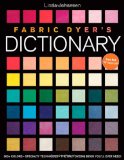Dylon Cold dyes are no longer available. How can I mix a substitute for Sahara Sun?
Dylon Cold dyes are no longer available. How can I mix a substitute for Sahara Sun?
Name: Ann
—ADVERTISEMENTS—

Linda Johansen's book
Fabric Dyer's Dictionary
shows how to mix a small number of Procion dyes to obtain a large number of different solid colors

Linda Knutson's book
Synthetic Dyes for Natural Fibers
provides an excellent introduction on how to dye with synthetic dyes.
Country or region: Denmark
Message: I have previously been using Dylon A22 Sahara Sun, but this is no longer being produced, so I need to figure out how to mix 'individual dyes' to make this mixture. On your website and on the MSDS only one dye (C.I. REACTIVE ORANGE 4 < 1% = Procion type Orange MX-2R) is listed. I was wondering if you have any further information on what could possibly be in the mixture from your experience? I am quite new to this!
Kindest Regards
Ann
 In the image to the left you can see that "Sahara Sun" was a yellow color, so yellow in hue that it can contain no more than a small amount of orange MX-2R. There are pure unmixed Procion MX type dyes that are similar in color to "Sahara Sun", but there would have been no need for Dylon to have added an orange dye to them to warm up their color, so I think that the yellow dye used in this case was probably the clear cool yellow known as Procion Yellow MX-8G. This is a common and easy-to-find dye, if you can access Procion dyes at all. It is possible that they also added a bit of a complementary color to dull down the color a little bit; you could try adding a little of a brown Procion dye mixture for a similar effect.
In the image to the left you can see that "Sahara Sun" was a yellow color, so yellow in hue that it can contain no more than a small amount of orange MX-2R. There are pure unmixed Procion MX type dyes that are similar in color to "Sahara Sun", but there would have been no need for Dylon to have added an orange dye to them to warm up their color, so I think that the yellow dye used in this case was probably the clear cool yellow known as Procion Yellow MX-8G. This is a common and easy-to-find dye, if you can access Procion dyes at all. It is possible that they also added a bit of a complementary color to dull down the color a little bit; you could try adding a little of a brown Procion dye mixture for a similar effect.You can see a list of which of the Procion MX dyes are the single-hue unmixed mixing primaries on my page, "Which Procion MX colors are pure, and which mixtures?". The color chips on that page are only approximate, but you can see that there are several yellow Procion MX dyes, ranging from cool to almost orange. There are some dye retailers, particularly in the US, that sell as many as a hundred different shades of Procion MX dyes, but these are all mixed from the same dozen or so single-hue mixing primaries.
The one dye supplier I know in Denmark, Granat Farvekompagniet, does not sell Procion MX dyes, as far as I know. They do sell another excellent line of fiber reactive dye, the Remazol dyes, which are similar to Procion dyes in how they work; however, they are less reactive, so they need a warmer reaction temperature than the dyes you've used in the past. (See my page "What is the effect of temperature on fiber reactive dyes?" for ideas on how to warm up your fabric or other fiber while it reacts with the dye.) Look at Granat Farvekompagniet's site to see the colors they show for their two different Remazol yellow dyes, Brill. Gelb GL (sunny yellow) and Brill. Gelb 4GL (lemon). Although the color chips on the web site for these two yellow dyes look very similar, Brill. Gelb GL is a warmer shade of yellow (that means slightly more orangish), so will be closer without mixing to the color that you have been using.
To continue with the same Procion dye type you have used in the past, you may have to mail-order from another country, unless you can find a source in Denmark for Procion MX dyes. Look at my page of "Sources for Dyeing Supplies Around the World"; scroll down to the "Europe" section. I have marked in that list which ones carry Procion MX dyes.
Also see my blog post "Mixing Colors with Dylon Cold Dyes", dated July 13, 2009, and my frequently asked questions pages, "How can I mix Procion MX dyes to get specific colors?".
(Please help support this web site. Thank you.)
(Please help support this web site. Thank you.)
Posted: Monday - September 10, 2012 at 09:09 AM
Follow this blog on twitter here.
Quick Links
- All About Dyes & Dyeing Top -
- Top of this blog -
- FAQ -
- The Dye Forum -
- How to Tie Dye - How to Batik -
- Books - Toys - Plants -
- Top of this blog -
- FAQ -
- The Dye Forum -
- How to Tie Dye - How to Batik -
- Books - Toys - Plants -
More in this category:
- -
Statistics
Total entries in this blog:
Total entries in this category:
Published On: Sep 10, 2012 09:28 AM
Total entries in this category:
Published On: Sep 10, 2012 09:28 AM